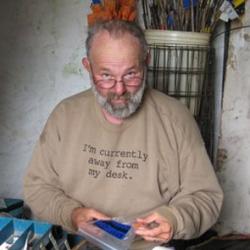BCR 172: Jeffrey Spendelow, PhD on Roseate Terns
 Jeff Spendelow received his Ph.D. (1980) and B.S. (1972) degrees in Biology from Yale University. In 2008 he was elected as a Fellow of the American Ornithologists’ Union, and he has been a Life Member of the AOU; a Founding Life Member of Connecticut Ornithological Association (COA) and several other ornithological societies since the 1970s. He started working on Roseate Terns in 1977, was Director of the Falkner Island Tern Project from 1981-2003, founded the Cooperative Roseate Tern Meta Population Project (CRTMP) in 1987, is a member of the U.S. Fish & Wildlife’s (USFWS) Roseate Tern Recovery Team, and after 35+ years as a federal employee he retired in December 2018 to become an Emeritus Research Wildlife Biologist. Jeff has authored or co-authored more than 70 publications, his research played an important role in the decisions by the USFWS to list Roseate Terns as Endangered and to add Falkner Island, CT to the National Wildlife Refuge system, and he continues to direct the CRTMP which now includes cooperators spanning the entire range of the Northwest Atlantic breeding population from Connecticut to Nova Scotia. Since 2011 he has focused his attention on learning more about the factors that might impact individuals of different ages and breeding status in their use of summer staging sites, especially those sites in the “Cape & Islands” area of Massachusetts.
Jeff Spendelow received his Ph.D. (1980) and B.S. (1972) degrees in Biology from Yale University. In 2008 he was elected as a Fellow of the American Ornithologists’ Union, and he has been a Life Member of the AOU; a Founding Life Member of Connecticut Ornithological Association (COA) and several other ornithological societies since the 1970s. He started working on Roseate Terns in 1977, was Director of the Falkner Island Tern Project from 1981-2003, founded the Cooperative Roseate Tern Meta Population Project (CRTMP) in 1987, is a member of the U.S. Fish & Wildlife’s (USFWS) Roseate Tern Recovery Team, and after 35+ years as a federal employee he retired in December 2018 to become an Emeritus Research Wildlife Biologist. Jeff has authored or co-authored more than 70 publications, his research played an important role in the decisions by the USFWS to list Roseate Terns as Endangered and to add Falkner Island, CT to the National Wildlife Refuge system, and he continues to direct the CRTMP which now includes cooperators spanning the entire range of the Northwest Atlantic breeding population from Connecticut to Nova Scotia. Since 2011 he has focused his attention on learning more about the factors that might impact individuals of different ages and breeding status in their use of summer staging sites, especially those sites in the “Cape & Islands” area of Massachusetts.
Show Notes:
- Your work with the Roseate Tern made a significant contribution for the listing of this species as Federally Endangered. What did it take to get this species listed?
- The Roseate Tern has a very interesting and somewhat odd world wide distribution. Tell us about this and do you have any speculation why the colonies are so dispersed?
- Townsend Dickinson remembers that you had installed many protected nesting sites for Roseate Terns on Falkner’s Island some years ago. Some were made from old tires; others were merely driftwood propped up by cobblestones. You noted at the time that these tern condos might give the Roseate’s a better chance at producing young. What was going on here?
- Tell us why the Federal Government has an interest in the Roseate Terns?
- You have been the Director of PWRC’s Cooperative Roseate Tern Meta-population Project (the CRTMP) ever since organizing it in 1987, what is this body and what do they do?
- You are the USGS member and Chair of the Technical Working Group of the USFWS’s Recovery Team for the endangered NW Atlantic breeding population of Roseate Terns. What effort does this entail?
- Some terns may be seen with secondary colored bands or flags, why do researchers give them auxiliary bands or other devices?
- Where are the main staging areas for Roseate Terns in the Northeast US?
- What effects does the presence of nearby people have on the nesting and fledglings success of Roseate Terns on Cape Cod?
- You recently transitioned to Emeritus Research Wildlife Biologist fromPatuxent Wildlife Research Center (PWRC) in Laurel, MD If you follow the model set by your esteemed fellow scientist Chandler S. Robbins also of Patuxent, this means you could have 30 or more years of work to do. Seriously do you have a plan yet?
BirdCallsRadio additional information:
To Support BirdCallsRadio & Podcast please DONATE NOW
BirdCallsRadio ON THE GO! Subscribe directly on ApplePodcasts; Stitcher; Google Play; Spotify; iHeartRadio to our podcast for Mac, PC & Android users emailed to you automatically so you won’t miss any BCR podcasts; and please leave us a rating and review if you would be so kind! We appreciate it!
Subscribe to our FREE E-Newsletter and be part of something greater. Stay up to date on all our episodes and exclusive offers by clicking on BirdCallsRadio and scrolling to the bottom and sign up with your email. All emails are confidential.

Great podcast, was wondering when the staging area occurs (what month) for the terns at the cape?